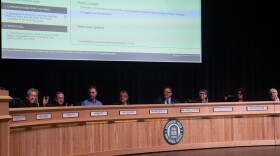Heat waves like the one we experienced about a week ago are relatively rare in San Diego. But, climatologists predict they'll be a lot more frequent and severe by the end of the century. Scientists say that means we'll likely see more heat-related illnesses and deaths. KPBS Health Reporter Kenny Goldberg has the story.
In late July 2006, California suffered through its worst heat wave on record. The thermometer hit 115 degrees for several days in a row in parts of the state.
Dr. Colleen Buono works in the emergency department at UCSD Medical Center in Hillcrest. She says the elderly are especially vulnerable to heat.
Buono: A lot of it has to do with they can't tell when they start becoming dehydrated, and it's this very steep slope that they fall down. And so they'll take their medication that blocks their ability to sweat. They don't drink very much, they're in a warm place, they don't move around a lot, they don't take precautions to cool themselves off. And then all of a sudden they're altered, somebody can't wake them up, and they end up in here in the emergency department.
Dr. Buono says if the body isn't cooled down, things can quickly spiral out of control.
Buono: And if the actual temperature itself in your body stays up above a certain level for a very long time, you can actually die from it.
When the 2006 heat wave finally broke, 141 Californians were dead. Most of them were seniors. Climatologists say global warming will take its toll in the coming years.
Gershunov: And it's possible that by the end of the century, a heat wave of the magnitude of 2006 would be a run-of-the-mill heat wave event.
Dr. Alex Gershunov is a climate researcher at the Scripps Institution of Oceanography in La Jolla. He says during the 2006 heat wave, daytime temperatures were at record-breaking levels. But Gershunov says it also didn't cool off much at night. He points out that's part of a trend in Southern California.
Gershunov: The atmospheric circulation that's associated with heat waves, the same circulation that brings in hot air from the south, is now tending to bring in humid hot air. And that makes heat waves expressed much more strongly at night. They're still hot during the day, they're just much hotter at night.
That makes heat waves much more difficult to tolerate, particularly for the elderly. Heat is the primary weather-related cause of death in the United States. But heat-related fatalities are preventable. When the thermometer rises, San Diego County Health officials try to help people stay cool.
It's midday at the Salvation Army Nutrition Center in El Cajon. Dozens of local seniors are enjoying lunch. Outside, it's sweltering. Inside, people can relax in air-conditioned safety. That's the idea behind the County's cool zone program. Every summer, the County designates more than 130 cool zones. They're places like libraries and courthouses…where seniors can take a break from the heat. Pam Smith directs the County's department of Aging and Independent Services.
Smith: So the whole thing's been a great way for us to really talk to people about coming in and being connected, about some of the dangers of dehydration and heat, and what people can do. We have tips, and all kind of help for them, and then we also distribute fans."
But many older people don't heed warnings about the heat. 900 seniors were recently interviewed in four cities nationwide. Almost everyone was aware when there was a heat alert. But only about half changed their behavior. El Cajon resident Cleo Metevier is 95-years-old.
Metevier: Do you do anything differently when it gets real hot out? No, I just, the same all the time. I never change anything. It's supposed to be 93 today, it was 93 yesterday. But I never turned the fan on.
Researchers say if global warming continues, summer temperatures in the state could rise by more than ten degrees by the end of the century.
Kenny Goldberg, KPBS News.






